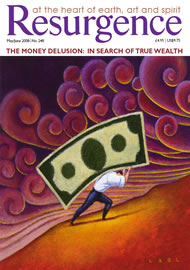IN DEFENSE OF FOOD is Michael Pollan’s latest indictment of the industrial food system in the United States. Following swiftly on the heels of his bestselling The Omnivore’s Dilemma, it establishes him as the doyen of the ‘cornographic’ romp. Each work deals with the consequences of placing an increasingly small number of foodstuffs – mainly corn, soybeans and wheat – at the heart of the US diet.
Pollan’s central thesis in In Defense of Food is that in the US – and, increasingly, in other parts of the Western world – people have lost any sense of a food culture. He contends that “most of what we’re consuming today is no longer, strictly speaking, food at all, and how we’re consuming it – in the car, in front of the TV, and, increasingly, alone – is not really eating, at least not in the sense that civilization has long understood the term.”
In this strange no man’s land, we become susceptible to the allure of what Pollan calls “foodlike substances”, namely the microwave dinners, cereal bars and yoghurt drinks that fill the supermarket shelves and are beamed from our television screens. Of course, Pollan is not the first writer to point this out. Wendell Berry noted back in 1977, “That agriculture is in so complex a sense a cultural endeavour – and that food is therefore a cultural product – would be regarded as heresy by most of the agencies, institutions, and publications of modern farming.”
Add to that the instruments of food-processing and marketing companies, and both authors’ point is the same: once we lose our sense of the origin, ingredients and context of our foodstuffs, we lose our ability to distinguish between good and bad food choices; we are, increasingly, confused. And that is precisely where the marketers step in.
In order to explore the roots of this confusion, Pollan begins by outlining the origins of the hyper-processed Western diet and explains the related rise of what he refers to as “nutritionism”: the fixation on a food’s constituent parts – vitamins, fats, sugars, and so on – rather than on the food itself. The view that only scientists can dictate which foods – or parts of food – are good, and which are bad, has led us to lose control of our diet and instead handed that control to the food processors.
Rather than looking at a food item and making decisions about it according to our senses, culture and appetites, we turn the package around and instead examine the label. From this emerges the paradox that Americans, increasingly unhealthy, are at the same time more obsessed with healthy eating than ever before.
Pollan argues that we are simply making the wrong sorts of choice, wryly pointing out, “it’s a whole lot easier to slap a health claim on a box of sugary cereal than on a raw potato or a carrot, with the perverse result that the most healthful foods in the supermarket sit there quietly in the produce section, silent as stroke victims, while a few aisles over in Cereal the Cocoa Puffs and Lucky Charms are screaming their newfound ‘whole-grain goodness’ to the rafters.” Pollan asserts that we should dispose of this reductionist view of food and approach it more holistically, arguing for the creation of “a broader, more ecological – and more cultural – view of food.”
This established, Pollan goes on to lay out what he labels “algorithms” for healthy and, most importantly, enjoyable eating; algorithms that essentially boil down to the delightfully simple mantra presented at the beginning of the book: ‘Eat Food. Not too much. Mostly plants.’
Eminently sensible, often funny, and always well considered, In Defense of Food may not be quite as compelling as The Omnivore’s Dilemma, but it is an important work nonetheless. Arming us with the critical tools to examine the industrial-food complex as it currently operates, and emphasising the forgotten pleasures of food as a cultural experience, Pollan shows us how to begin anew.







